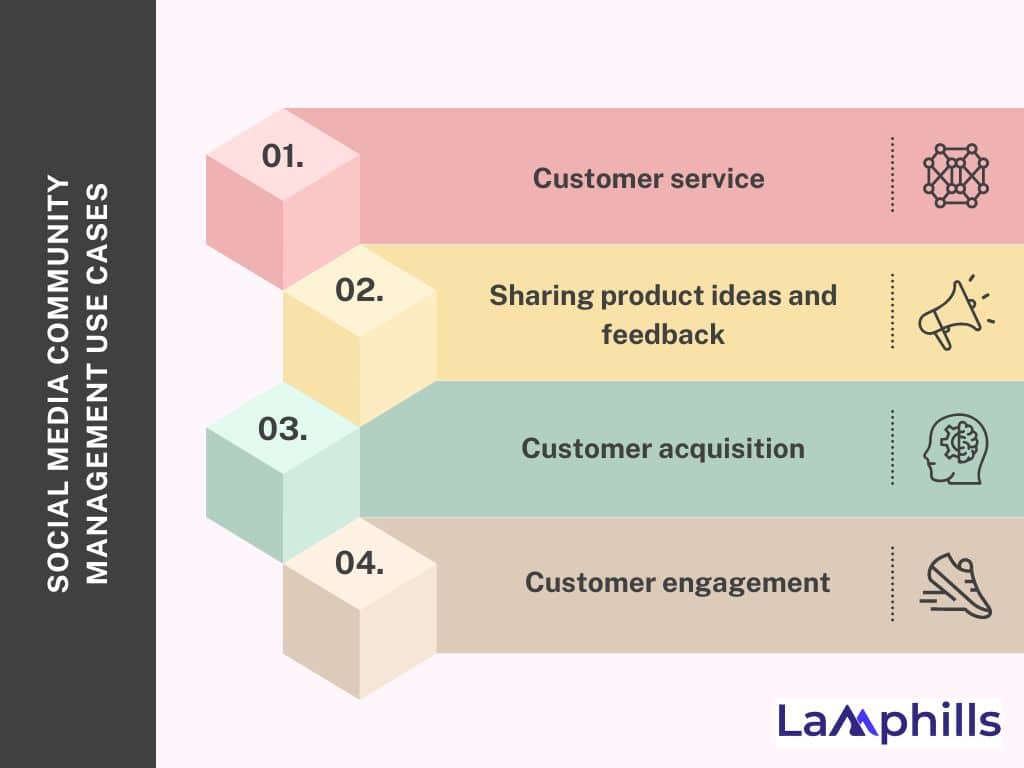How can social media community management shift from just reaching people to actively engaging with them? This question highlights the importance of modern digital marketing, where building a lively online community is key to brand success.
In a time when every scroll, like, and comment is a chance to connect with your audience, mastering social media community management has become more important than ever. In this article, we’ll explore strategies that help brands to succeed in the constantly changing world of social media.
From addressing tough questions to engaging with your audience, each strategy we discuss can boost the effectiveness of your community management. Let’s get started.
Key Points
- Successful social media community management requires a deep understanding of your audience’s needs, preferences, and behaviors.
- Effective community management involves actively engaging with your community members.
- The content shared within the community should be valuable, relevant, and aligned with the audience’s interests.
- Continuously monitoring and responding to feedback is essential for maintaining a positive brand reputation and improving products or services based on community input.
- Tracking key metrics like engagement rate, follower growth, and sentiment analysis helps in refining strategies to better meet the community’s needs and improve overall social media performance.
What Is Social Media Community Management?

Image by Freepik
During a busy week managing social media for a fashion brand, I noticed a customer who shared her experience styling our products with her followers. I featured her story on our channels, tagged her, and thanked her personally. The response was incredible; followers were inspired and began sharing their stories, flooding our pages with user-generated content. This experience showed me that social media is more than just marketing; it’s a powerful tool for building communities and amplifying the brand’s voice.
Social media community management isn’t just about posting content and replying to comments. It’s about creating a space where your audience feels listened to, valued, and engaged. It’s the process of building relationships and creating a group of loyal followers who not only support your brand but also speak up for it.
Throughout my experience, I’ve learned that understanding your audience is key. Every community is unique. Some may enjoy humor, while others might prefer educational content. The secret is to listen to what your community is saying and respond in a way that connects with them.
In simple terms, social media community management aims to create an active online community by sharing creative content, like short videos and trendy posts, to boost brand awareness, reach, and loyalty.
Social Media Community Management Use Cases

Social media community management can be used in different ways:
1. Customer service: To support and help customers through social media.
2. Sharing product ideas and feedback: Using online communities to test new products and collect customer opinions.
3. Customer acquisition: To attract and engage potential customers interested in your products.
4. Customer engagement: Building online communities to connect customers to your brand.
5. Employee engagement: Engaging current employees and attracting new talent to your brand as a good workplace.
Social media community management is important for your business for many reasons, and here’s why.
Why Do You Need a Social Media Community Management Strategy?
Managing your online community helps you connect with your brand’s followers and earn their trust by being available whenever they need you.
By creating and following a solid community management plan, brands can set themselves up for lasting success and steady growth. Here’s why you need a social media community management strategy:
#1. Collect customer feedback often.
Talking with your customers in real-time on social media gets them involved and encourages them to share their opinions about your brand. This can give you a clear picture of how your brand is seen in the market, whether for good or for bad.
#2. Strengthen and improve customer relationships.
Community management helps you respond quickly and support your customers. You learn about their likes, preferences, and expectations, which helps you serve them better. This way, you can build strong relationships and foster loyalty.
It also allows you to create both one-on-one and group customer relationships.
#3. Improve brand recognition
A recent study shows that brand recall affects 38.7% of how people view a brand. Good community management helps keep your reputation strong on social media and turns more customers into loyal supporters, which can also increase your sales.
#4. Encourage brand authenticity
Faking it doesn’t work on social media anymore. People can easily tell what’s real, so being authentic is the best way to build brand loyalty. In fact, 90% of consumers say authenticity is a key factor when choosing a brand. Also, millennials and Gen Z prefer genuine and natural brands over those that seem too polished or perfect.
Now, let’s see the elements of community management on social media.
Elements of Social Media Community Management
Managing a social media community well involves handling several different tasks. Each part is important for building a lively and active online community, from creating content to managing crises.
Here are the key parts of community management:
1. Content creation and sharing: Community management involves creating and sharing a variety of content that matches the interests of the audience.
2. Engagement and interaction: Brands need to actively engage with their followers by responding to comments, direct messages, and mentions. This keeps the community involved and strengthens connections.
3. Moderation: Keeping an eye on discussions, enforcing rules, and addressing inappropriate behavior helps create a safe and positive environment for everyone.
4. Collecting and analyzing feedback: Social media managers gather feedback through surveys, polls, and questions, using the information to spot trends and opportunities. Analyzing this feedback helps make better decisions and improve continuously.
5. Advocacy and relationship building: Recognizing and rewarding active community members strengthens relationships and helps identify brand advocates.
6. Crisis management: Open communication, acknowledging concerns, and providing timely updates help reassure the community and protect the brand’s reputation.
7. Analytics and reporting: Reviewing performance data helps identify what’s working well and what needs improvement, guiding future strategies for better results.
Now, let’s learn the principles that guide community management on social media.
Social Media Community Management Strategy -Best Practices

Image by Gerd Altmann from Pixabay
No successful community can thrive without the hard work of social media community managers. Community management is about building relationships and keeping the community a positive place for everyone, which helps protect the brand’s reputation. But it’s more than just answering messages or posting updates.
Community managers create open conversations, stay aware of members’ needs, and turn casual fans into loyal supporters by using their feedback to grow and improve.
Here are seven practical tips to boost your social media community management skills. These tips will help you effectively connect with your audience and build a strong online community.
#1. Know Your Audience
Understanding your audience is key to managing a community well. It’s not just about knowing who they are but also understanding their needs, preferences, and behaviors. This knowledge will guide everything you do in the community, from the content you post to how you interact with members.
Part of knowing your audience is knowing their demographics, such as age, industry, job level, and location. These factors can shape the kind of community you run. For instance, younger adults may prefer casual, quick content, while older members might like longer, detailed posts. Understanding your audience’s demographics helps you meet their needs and create a more inclusive and relevant experience, leading to better engagement and loyalty.
To get to know your audience better, you can:
- Use social listening tools to follow conversations about your brand and industry.
- Look at analytics on social media to see when your audience is most active and what content they like.
- Conduct surveys and polls to get direct feedback from your community.
- Monitor comments to get a sense of how your audience feels.
- Create personas representing different segments of your audience to understand them better.
By using these strategies, you’ll gain a deep understanding of your community members, which is crucial for successful community management.
#2. Set Clear Community Rules
Having clear community rules is important for keeping your community positive and productive. These rules guide how members interact, ensuring the platform stays respectful and safe. Clear rules let members know what behavior and posts are acceptable, setting the standard for interactions. When new members join, make sure to point out these rules so they know what to expect.
While some might think rules are restrictive, they are essential for encouraging meaningful discussions and reducing conflicts. When members feel safe and respected, they’re more likely to participate and contribute.
Examples of community rules include:
- Be respectful
- Be supportive
- Stay on topic
- No spam or self-promotion
- Report violations
- Protect privacy
- No lead generation
By setting and enforcing these rules, community managers can create a welcoming and constructive environment that encourages engagement and provides a positive experience for all members.
#3. Be Involved with Your Community
Simply letting your community members interact with each other isn’t enough. As a community manager, you must be actively involved in building relationships and creating a strong sense of community. By engaging directly with your members, you show them that you value their presence and opinions, which can lead to stronger loyalty and support for your brand.
There are many ways to connect with your community; you can:
- Ask open-ended questions to encourage discussion.
- Create polls to gather opinions and engage members.
- Start discussions on relevant topics that matter to your community.
- Reply to comments and messages from community members to acknowledge their input and show responsiveness.
- Host live video sessions on platforms like Instagram and TikTok for Q&As, behind-the-scenes tours, or casual chats.
- Share content created by your community to provide fresh material and involve members more closely.
- Celebrate milestones or achievements, both for your brand and for individual community members, to build personal connections.
By staying engaged, you’ll create a lively and responsive environment that benefits your brand and community members.
#4. Monitor and Respond to Feedback
Keeping track of feedback and responding to it is a key part of managing your community. You should pay close attention to what your audience says about your brand and positively engage with them.
This helps protect your brand’s reputation and gives you useful insights into your members’ experiences and expectations. To achieve this:
- Use social media monitoring tools like Hootsuite or Sprout Social to track mentions, comments, and conversations about your brand across different platforms.
- Set up Google Alerts to receive notifications whenever your brand is mentioned online.
- Monitor relevant keywords and hashtags related to your brand or industry to join broader conversations and gauge public sentiment.
- Respond to negative feedback or complaints quickly and professionally.
- Acknowledge issues, offer solutions, and take the conversation offline if needed.
- Avoid using automated responses; tailor your replies to each situation.
- Use negative feedback as an opportunity to improve your products or services.
- Keep track of complaints to identify recurring issues or areas for improvement.
- Follow up with community members to ensure the problem has been resolved and they are satisfied.
- Maintain a consistent brand voice throughout all interactions to build trust and credibility.
We’ve included a simple feedback collection form in the article to help you gather valuable insights from your community. This form is designed to help you understand what your members enjoy and where improvements can be made. Use it as a tool to keep your community thriving and engaged.
By using this feedback collection form, you’ll gain a better understanding of your community’s needs and preferences. This valuable insight will help you make informed decisions, ensuring your community continues to grow and remains a positive space for everyone.
#5. Create Valuable and Relevant Content
As a social media community manager, it is crucial to create content that is both interesting and relevant to your community. Your content should reflect your brand’s message while meeting your community members’ needs and interests. Striking this balance helps keep your community engaged and ensures it remains a valuable resource.
Start by figuring out what kind of content your audience likes. Use your analytics to see which posts get the most engagement and shares, and this will guide you in creating content that resonates with your audience. Stay updated on industry trends to keep your content fresh and relevant.
While promoting your brand is important, avoid overwhelming your community with too much sales-driven content. Follow the 80/20 rule: 80% of your content should be informative, educational, or entertaining, with only 20% being promotional. This approach ensures your social media feed engages without overly focusing on selling.
For the 80%, share content your members find interesting, whether it’s about your industry, brand, or topics they care about. This positions your brand as a knowledgeable and trustworthy source. As your community evolves, continue to update your content strategy to match their changing preferences, ensuring you always deliver what they want to see.
#6. Use User-Generated Content
Including user-generated content (UGC) in your social media strategy is a great way to engage your audience and make your brand feel more authentic. UGC is any content created by your community members, not your brand. It’s a valuable asset because it can:
- Increase authenticity and trust
- Boost engagement
- Serve as a strong endorsement
- Add variety to your content
- Strengthen the sense of community
To gather UGC, make it easy for members to share their content. Create branded hashtags for your community to use so you can easily find and showcase their posts. Encourage members to leave reviews or share their experiences with your products, and consider offering incentives like a chance to win a prize or get a discount for sharing a testimonial.
You can also organize contests or challenges that inspire members to create and share content. This not only generates excitement but also promotes active participation. When you receive UGC, regularly feature it on your social channels, give credit to the creator, and show appreciation. This kind of active engagement will spread the content further and encourage more users to create and share their own.
#7. Use Data to Improve Strategies
Data is important for understanding how well your social media community management works and helps you make better decisions. By tracking the right metrics and analyzing the data, you can better adjust your approach to meet your community’s needs and preferences.
Key metrics to track include:
- Engagement rate
- Reach and impressions
- Follower growth
- Click-through rate
- Conversion rate
- Sentiment analysis
Once you have the data, you can find patterns to guide your future strategies. For example, identify which posts perform best and see their commonalities. Is it the type of content (like videos or photos) or the topics they cover? Use these insights to shape your future content.
You can also track when your posts get the most engagement, helping you find the best days and times to post and how often you should post. This enables you to keep your community interested without overwhelming them. Use sentiment analysis and engagement metrics to figure out what content your audience likes and what they don’t. Adjust your content strategy to focus more on what your audience enjoys.
Use past data to set realistic goals for your social media performance, and regularly check your progress to make any needed changes. By using data, you take the guesswork out of the process. Analyzing the data and making ongoing adjustments will improve your social media performance and help you build a more engaged and loyal online community.
Managing an online community can be challenging, but with the proper steps, you can create a space where everyone feels welcome and engaged. This checklist will guide you through the basics of effective community management, helping you build strong relationships and keep your community active and positive.
4 Social Media Community Management Examples From Real Brands

Image by Aim Tech
Strong brand communities bring people together by sharing a connection to a company’s mission, vision, or goals. Discover how to turn your business needs into a loyal and active fan base with these social media community management examples:
#1. Nike
Nike is well-known for its active presence on social media, especially on platforms like Instagram and Twitter. They often respond to customers’ comments, whether it’s praise, questions, or even complaints. For instance, if a customer posts about their new Nike shoes, Nike might respond with a motivational message or simply thank them. This makes customers feel valued and connected to the brand.
#2. Starbucks
Starbucks has mastered the art of engaging with its community on social media. It often runs campaigns where it asks customers to share their experiences or favorite drinks using specific hashtags. Starbucks then shares some of these posts on its official accounts, which encourages more people to participate. This strategy helps build a sense of community among its followers and keeps them engaged with the brand.
#3. Lush
Lush, the cosmetics brand, is deeply committed to social and environmental causes, and they reflect this in their social media community management. On platforms like Instagram, Lush promotes its products and actively engages in conversations about sustainability, ethical sourcing, and other important issues. They often share user-generated content, where customers showcase their favorite Lush products and respond with thoughtful comments. Lush also uses social media to educate their community about the ingredients in their products and the causes they support, which fosters a strong, values-driven connection with their followers.
#4. Wendy’s
Wendy’s is famous for its witty and playful interactions on Twitter. They often respond to customers and even other brands with humor, making their accounts entertaining to follow. Wendy’s is also known for engaging in light-hearted “roasts” or jokes, which attract users’ attention and interaction. This approach makes the brand memorable and encourages more people to engage with them online.
These examples show how effective social media community management can help brands build stronger relationships with their audience, increase engagement, and create a loyal customer base.
Conclusion.
In summary, managing a social media community isn’t a one-time job; it’s an ongoing commitment. It requires patience, creativity, and a genuine interest in the people behind the screens. But the rewards are worth it. Building and nurturing a thriving online community can take your brand from just another name out there to something people truly care about and trust.
Remember, a strong community comes from the real value, support, and interaction you offer. It’s not just about waiting for customers to connect with your brand; it’s about being proactive, engaging with your audience, and building meaningful relationships.
Answers to FAQs.
Social Media Manager vs. Community Manager: Which One Do You Need?
A community manager and a social media manager aren’t the same. While social media managers often take on community management duties, this isn’t always the best approach.
Social media managers already handle many tasks, such as planning social media strategies, designing graphics, writing copy, and creating content. Adding community management to their workload can weaken community engagement.
A better solution is to hire a dedicated community manager to work alongside your social media team. A community manager can focus on building strong community management systems that fit seamlessly into your social media strategy, leading to more effective engagement.
What does a social media community do?
A social media community is a group of people who connect online to share common interests and experiences. This can include any online group, such as forums, chat rooms, and social networking sites.
What is an example of a social media community?
Examples include Reddit subreddits, Pinterest boards, and Facebook groups for specific hobbies or podcasts. Reddit, for instance, is a social media platform and online community where users can join discussions, share content, and connect with others on many different topics.
Here’s a simpler version:
How do I start a social media community?
10 Easy Ways to Build and Engage a Community on Social Media
1. Make it personal: Share your own stories and listen to others’ stories.
2. Communicate with your followers: Engage with them regularly.
3. Keep it simple: Make your content easy to understand and accessible.
4. Use social analytics: Understand your audience better by analyzing data.
5. Be transparent: Share clear and honest information.
6. Promote other interests: Talk about topics that align with your brand but aren’t the main focus.
7. Offer incentives: Encourage participation with rewards and events.
8. Solve problems: Help your followers by addressing their challenges.
9. Tag community members: Mention and involve others in your posts.
10. Show your passion: Let your enthusiasm and dedication shine through.
Is Facebook a social media community?
Facebook is a social media site that helps you connect and share with your family and friends online. It was first made for college students, and Mark Zuckerberg created it in 2004 while he was studying at Harvard University.
Is TikTok a social community?
The content is carefully selected. It’s great that new creators can become popular faster than on other platforms.
Is WhatsApp a social media platform?
Yes, WhatsApp is considered a social media platform. The main social media platforms right now include Instagram, Facebook, WhatsApp, TikTok, Twitter, LinkedIn, Pinterest, YouTube, and Snapchat. Facebook is the biggest, with almost 3 billion people using it every month.
Similar Articles
Social Media Monitoring Platforms: An Expert Guide to Improve Your Engagement
Top 10 Corporate Social Responsibility Strategies for 2024: A Guide for Modern Businesses
How to Become a Social Media Influencer: A Detailed Guide for 2024






